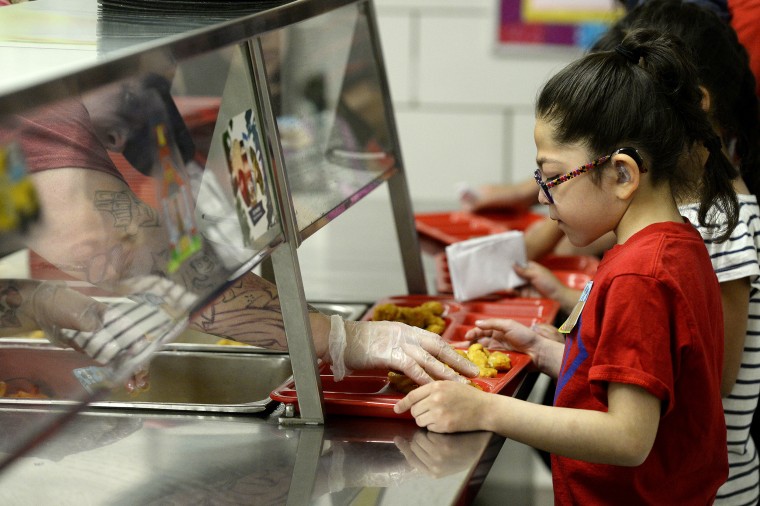Democratic lawmakers will introduce a bill late Wednesday to make permanent a temporary children’s summer food program created because of the pandemic.
The proposed law would cement and slightly expand a program first created in the American Rescue Plan that provides cash for an estimated 33 million kids in low-income families. Earlier this year, the Biden administration called it “the largest summer food program in U.S. history.”
The effort would also secure one piece of the expanded social safety net the country has developed during the national emergency created by Covid-19 — just as some Republican states are beginning to cut such benefits.
“We’ve seen lines that stretch for miles at food banks across the country this past year — this pandemic has to be a wakeup call for America,” said Sen. Patty Murray, D-Wash., who will introduce the bill Wednesday. “Hunger doesn’t take time off when school buildings are closed, so neither can we.”

The current program provides families of children eligible for free and reduced-price lunch with an electronic benefit transfer card, essentially a debit card with a set amount of money, to buy food when kids are out of school in the summer. This new program will expand to include all holidays or when schools are operating remotely or in a hybrid model.
The amount the families would receive on the EBT card would not be less than the value of the meals they would normally receive through a free or reduced-price lunch at school, according to the legislation. The amount would likely be set each October by the U.S. Department of Agriculture.
This summer that will be about $375, or nearly $7 per weekday for the months children are not in school.
Murray will join with Reps. Mike Levin, D-Calif., and Jahana Hayes, D-Conn., to introduce the bills on the Senate and House sides respectively on Wednesday.
The bill, called the Stop Child Hunger Act, would effectively convert and expand the pandemic’s summer EBT program to replace the USDA’s longtime summer food initiatives, which have long been criticized by health economists and even those who run them.
"Every year, we run one of the USDA Summer Food Service Programs, which is heavily focused on lunch. We'll serve several thousand kids, but it's a fraction of the amount who get meals during the school year," Los Angeles Regional Food Bank President Michael Flood said. "We can see the information year after year that there's a program design issue."

A Senate staffer who worked on the legislation and asked to remain anonymous to speak freely about the program said it would cost about $8 billion per year, citing an analysis produced for Murray’s office by an outside group. The USDA estimated the new summer program would cost about $12 billion annually.
Murray, who serves as the chairwoman of the Senate Health, Education, Labor and Pensions Committee, has pushed to pass similar legislation since 2014. Her office sees a rare window to get the bill through in the coming months.
“We think we have the best chance that we've had since we introduced the bill in 2014 to pass,” the staffer who worked on the legislation said. “The two pathways currently are either through the child nutrition reauthorization or the infrastructure package.”
The Child Nutrition Act, which encompasses many of the food programs that feed low-income families, is up for reauthorization this year. While it has received bipartisan support in the past, in recent years it has not been fully reauthorized because of bipartisan divisions. Meanwhile, Democrats and Republicans do not appear close to hammering out a deal on the infrastructure package, though President Joe Biden has included a form of Murray’s bill in the most recent plan.
The staffer admitted they are hanging their hopes on the Democrats’ slim margins in Congress, as “it’s tough in general to get Republicans on a nutrition bill.”
That’s a change from the past, said Parke Wilde, a professor at Tufts University’s Friedman School of Nutrition Science and Policy.
“Nutrition assistance programs have a long history of bipartisan support, but for approximately the last five years that tradition has frayed. Just like with everything in U.S. politics, it has become highly partisan," Wilde said. “The next round of policy on this is only likely to pass with mainly Democratic support.”
Families will have access to the benefit for the next two years because of its inclusion in the American Rescue Plan. Democrats are hoping that will increase political pressure to pass the bill and make the food program permanent.
While some noted minor concerns over costs of the food programs created during the pandemic, health economists emphasized that these recent food initiatives are not particularly extravagant.
“This is not the three martini lunch in the old days of midtown Manhattan,” said James Ziliak, an economist at the University of Kentucky who studies health and nutrition programs. “These are not exorbitant benefits, but they do provide much-needed assistance to low-income families.”
Ziliak emphasized that adequate nutrition is crucial for childhood development, both in the short and long term.
USDA pilot programs that ran between 2011 and 2014 showed the proposed summer programs to be effective. Families that received between $30 and $60 per month per child saw a significant decrease in food insecurity, and it led to positive nutritional outcomes among children.
"There were substantial reductions in childhood insecurity among those households that had access to that," Ziliak said. "So there's kind of a good baseline evidence to suggest that expanding food assistance during the summer months can have important benefits to children."


